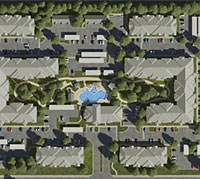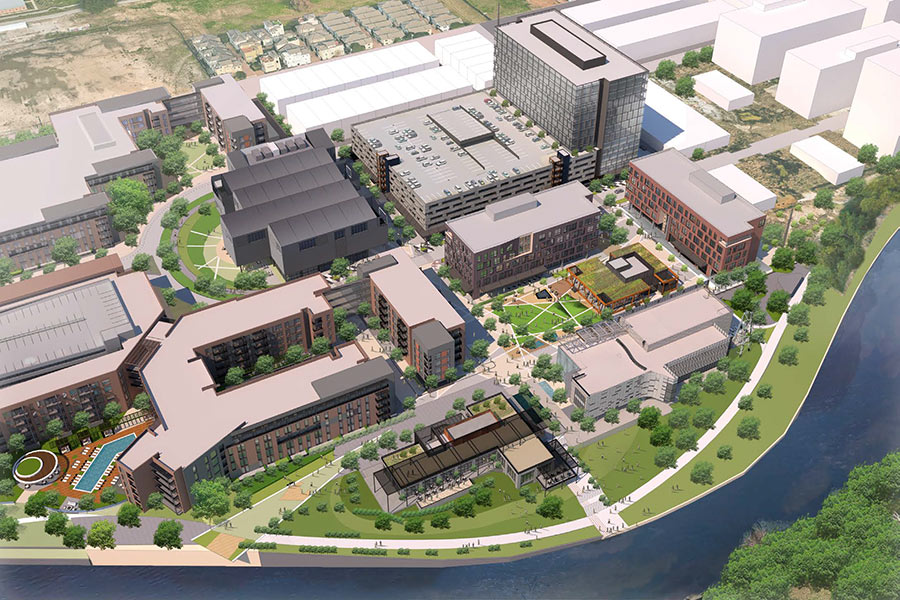FEEDING NEW APARTMENTS TO THE GRAND PKWY. FEEDER  Austin developers Oden Hughes say that they have been eager to build in Houston, but the company’s first project here has come only as far east as Katy: A 354-unit apartment complex is going up a few miles east of Katy Mills Mall on 14 acres at the southwest corner of Kingsland Blvd. and the southbound Grand Pkwy. feeder. The Rancher reports that rent here at the so-called Parkside Grand Parkway will range between $850 and $1,655 a month for the complex planned to include 2 pools, a fitness center, and “an air-conditioned dog washing station.” [The Rancher] Rendering: Oden Hughes
Austin developers Oden Hughes say that they have been eager to build in Houston, but the company’s first project here has come only as far east as Katy: A 354-unit apartment complex is going up a few miles east of Katy Mills Mall on 14 acres at the southwest corner of Kingsland Blvd. and the southbound Grand Pkwy. feeder. The Rancher reports that rent here at the so-called Parkside Grand Parkway will range between $850 and $1,655 a month for the complex planned to include 2 pools, a fitness center, and “an air-conditioned dog washing station.” [The Rancher] Rendering: Oden Hughes





I can kind of understand the exuberance with which they’re building new apartments Inside the Loop. There’s a big enough market for offices and employment there, that the new units will be supported.
.
But I really have my doubts at the ones who throw up new multifamily units way out in the suburbs. Yes, Katy is growing, and yes, as long as they just do one or two of these 350 unit complexes, they should have no problem absorbing the new units. But if they do more than that, neighbors should rightly be very worried that it will do serious damage in the long term.
These are the apartments in the suburbs that ppl should be upset about…. not the ones that are going up near Sugarland town center. In 30 years these will be slums.
Lower income people are likely to live in the outer ring cities this century so saying apts in Katy etc will absorb them in the future seems likely.
Admittedly, I’m very ignorant regarding real estate in the burbs (other than the airports, I never venture outside the loop*), but is there really a demand for this type of rental in Katy? I associate $1k one bedrooms with young professionals who want to be near nightlife, bars and resturants, not suburban life.
* According to “The Inner-Loopers Guide to All Things Snobby” chapter 6, page 9, paragraph 32 – “An Inner-Looper may travel to the Galleria, and other Galleria area stores, without having been considered to have been outside the loop, provided that their destination store(s) is(are) recognized as being a high end fashion icon on a global scale. Examples of destination stores, outside the loop, that meet this critera include Hermes, Jimmy Choo, Cartier, and Tiffany & Co.”
Future slums, indeed.
Oh goody, another future ghetto in 20 years –I feel for the people investing in houses near here–developers should have to bulldoze and rebuild apt developments that are deemed run down, they should be held accountable for these future slums they build
Cheap suburban ghetto apartment in 20 years.
In 50 years, they may be tearing these down to build some cheesy urban mixed-use type development, the suburban apartments that were build 20 years before that in Sealy will be turning into slums, and they will be building apartments like these in Colombus.
Shannon – it would be nice if they did that. But there’s no way it will ever happen. Multifamily Developers build and build and build during the boom years, and when the boom years come to an end, they high-tail it for the next booming market. They’ll never stick around to clean up their mess.
.
What we can do, however, is demand that HUD’s Low Income Housing Tax Credits (LIHTC) be used to rehabilitate existing complexes rather than building new low income complexes on open land. It works here because we have so many awful apartment complexes that already function as de-facto low-income housing.
.
This can be a hard sell to neighbors, and it has to be done the right way, but when it is done successfully, it really makes a difference. If it was policy across our region, you’d see a lot fewer slums.
Most apartment are nothing more than future ghettos. That just seems to be the way it goes.
You’re right ZAW, but geez what a trade off—drug dealers living off of narcotic sales or government supportered drug dealers living off of narcotic sales and our tax dollars–oh goody, sign me up!–seriously, it can work if the government forces standards for aid and for the right to live in government housing –I’m all for helping those who help themselves, but not for dead beat criminals
@ ZAW: There are already four apartment complexes within walking distance, and this’ll be the fifth. And there’s still plenty of vacant land nearby, so I’m positive that it will not be the last.
This is not a thin market.
The greater Katy submarket has 181 apartment communities comprising 14,579 units. Another 840 units are under construction, and now there are these. Occupancy is 96%, the same as the Heights. Average rents are $962 per month for units that average 912 square feet in size. (Units in Katy tend to be larger than units that cater to young urban professionals.)
The Katy submarket is comparable in size, occupancy rates, and rental rates to the Sugar Land/Ft. Bend submarket and The Woodlands submarket…all of which are in the top quintile of apartment submarkets in the Houston region.
It is entirely plausible that parts of Katy will degenerate over time into undesirable neighborhoods. Parts of it already have! Some of the single-family housing stock that’s been built here will be more problematic (and harder to erase from the landscape when the time comes) than the multifamily) IMO.
It does not worry me though. Poor people gotta live somewhere. WHY NOT right here in fifteen or twenty years?
Niche – I agree with you on the single family housing stock. Lots of the entry level subdivisions built in the 1990s and early 2000s are starting to develop problems. It’s only going to get worse if they don’t take measures now to address the issues of crime, concentrated poverty, etc. that are creeping in.
.
That said, the big difference between Sugar Land and The Woodlands, versus Katy, is that they have well established master plans, and Katy doesn’t. Sugar Land in particular very tightly governs growth, and while it can be frustrating for an architect like myself, I can’t say I blame them. A well thought out master plan will accommodate growth while ensuring access to assets like parks and schools; long term it’s the best way to prevent slums.
.
As far as the old “poor people have got to live somewhere” quip. The poor will choose where to live among the options that are available to them, just like the rest of us do. It behooves us to give them good options. Run down apartment complexes – isolated from parks and schools, and twenty miles from jobs – aren’t good options.
“It behooves us to give them good options. Run down apartment complexes – isolated from parks and schools, and twenty miles from jobs – aren’t good options.”
How can “we” prevent them from living in run down complexes? Parks and schools are usually nearby apts too. And the myth of low income people being far from jobs…what jobs? Fast food, retail, labor…these jobs are everywhere.I live in a lower income area and everyone seems to have vehicles and cell phones, although there is some ride sharing (and early morning horn honking…)and bus riding.
I have more faith in people figuring out for themselves how to make it rather than govt. The suburbs can help the overall situation by planning for a lot of lower income residents in the coming decades by keeping apts unconcentrated and having a decent bus or rail system. They’ll also need to budget for more schools and cops.
@ ZAW: But, in theory at least, the less isolated apartments should be the ones which retain more value, and therefore will be less affordable to the lower income population. (I realize this doesn’t always end up being the case. See: Gulfton.) And planning (which encompasses a very wide range of activities by the way, not necessarily including land use zoning) may not necessarily preclude the decline of formerly middle-class housing into low-rent districts – Chicago is famous for being “planned” but that didn’t stop it from converting 2/3 of its area into sad ghettoes. That said, I support many aspects of planning (hence my handle) because it can increase the odds that a location will retain sufficient “place value” over time to attract necessary reinvestment. (I just don’t support land use and density zoning for the most part.)
@ ZAW: It is going to get worse. There’s no saving grace for many of those single-family neighborhoods. Places that are built from scratch for poor people take on all those problems very quickly. They are this century’s Sunnyside.
But part of the Katy problem, as you or I might define it, is semantic. What people refer to as being “Katy” is a huge geographic area spanning swaths of three counties. North of I-10 is the pits, but south is okay and Cinco Ranch and other parts are just fine.
Sugar Land is an interesting case study for the Houston area because — you’re right that they are strict — but Sugar Land is much smaller than “Katy”. Their policies displace lower-cost housing into nearby communities. That’s not really solving anything, and if you are concerned about concentrated poverty then that is counterproductive.
Consider the Dallas area, a patchwork of competing cities, all of which would prefer to displace their poor people into the next city if such a thing could be accomplished. They go to great lengths to try to accomplish that. But the Dallas area STILL has poor people.
I for one do not believe that the Dallas area provides a good model for the development of Houston.